KDEConnect/de: Difference between revisions
Created page with "Durch das Anklicken dieser Erweiterung ermöglichen Sie es dem '''KDE-Connect'''-Mini-Programm den Ladestand ihrer Smartphone-Batterie anzuzeigen." |
Created page with "Mit dieser Erweiterung können Sie einfach einen Text von ihrem Rechner kopieren und er wird sofort in die Zwischenablage ihres Smartphones übertragen und andersherum. Dieses..." |
||
| Line 95: | Line 95: | ||
''"Teilen Sie die Zwischenablage zwischen den Geräten."'' | ''"Teilen Sie die Zwischenablage zwischen den Geräten."'' | ||
Mit dieser Erweiterung können Sie einfach einen Text von ihrem Rechner kopieren und er wird sofort in die Zwischenablage ihres Smartphones übertragen und andersherum. Dieses funktioniert allerdings nicht mit Bildern. | |||
===Inhibit Screensaver=== | ===Inhibit Screensaver=== | ||
Revision as of 19:13, 29 April 2020
Was ist KDE-Connect?
KDE-Connect ist ein Projekt das es allen Geräten erlaubt miteinander zu kommunizieren. Hier sind beispielsweise einige Dinge die KDE-Connect machen kann:
- Benachrichtigungen Ihres Smartphones auf ihrem Rechner anzeigen und auf Nachrichten antworten.
- Die Musikwiedergabe auf dem Rechner vom Smartphone aus steuern.
- Benutzen Sie ihr Smartphone als Fernsteuerung für ihren Rechner.
- Starten Sie von verbundenen Geräten vordefinierte Befehle auf ihrem Rechner. Vgl. die Liste mit Beispiel-Befehlen für weitere Details.
- Überwachen Sie den Batteriestatus des Smartphones von ihrer Arbeitsfläche aus.
- Lassen Sie ihr Smartphone klingeln, um es zu finde.
- Teilen Sie Dateien und Links zwischen den Geräten.
- Durchsuchen Sie ihr Smartphone von der Arbeitsfläche aus.
- Steuern Sie die Lautstärke der Arbeitsfläche von ihrem Smartphone aus.
- Senden Sie SMS direkt von ihrer Arbeitsfläche.
Installation
Sie werden die KDE-Connect-Komponente für die Arbeitsfläche höchstwahrscheinlich als Paket in den Repositories Ihrer Distribution finden. Falls nicht können Sie den Ersteller der Distribution darum bitten.
Entgegen eines weit verbreiteten Missverständnisses können Sie KDE-Connect nicht nur in KDE sondern in allen Arbeitsumgebungen nutzen. Da die meisten Entwickler KDE Plasma nutzen, kann es vorkommen, dass einige Funktionen in anderen Arbeitsumgebungen nicht funktionieren oder nicht zugänglich sind. In diesem Fall eröffnen Sie bitte einen Fehlerbericht in englischer Sprache. Es gibt viele Wege das KDE-Connect-Erlebnis auf Nicht-Plasma-Arbeitsumgebungen zu verbessern. Falls Sie GNOME-Nutzer sind werden Sie evtl. GSConnect, eine Erweiterung für die GNOME-Arbeitsumgebung, bevorzugen. Für Arbeitsumgebungen mit AppIndicator-Unterstützung (Budgie, Cinnamon, LXDE, Pantheon, Unity) gibt es Indicator-Kdeconnect.
Die App für Android gibt es im Google Play Store und in Katalog von F-Droid, dem Anbieter für Freie und Open-Source Software.
Es gab einige Arbeiten an der Entwicklung einer KDE-Connect-App für iOS im Jahre 2014, aber aufgrund unserer Erfahrungen und verschiedener technischer und organisatorischer Gründe ist es unwahrscheinlich das es in absehbarer Zeit eine offizielle App for iOS geben wird. Gerne können Sie sich den Quellcode anschauen.
KDE-Connect ist ebenfalls verfügbar für Sailfish [1] und wir arbeiten daran es auch auf anderen Linux-basierten Smartphones (Plasma Mobile, PostmarketOS, etc.) verfügbar zu machen.
Weiteres entnehmen Sie bitte der KDE-Connect-Download-Seite
Überblick
Dieses ist die Dokumentationsseite von KDE-Connect. Sie können auch auf die Gemeinschaftsseite von KDE-Connect engl. schauen. Diese Seite ist der Arbeitsbereich der Entwicklergemeinschaft.
KDE-Connect besteht aus zwei Teilen. Das Programm für die KDE-Arbeitsumgebung und die App für das Smartphone.
Das Pairing von zwei Geräten
Sie müssen zuerst KDE-Connect auf ihrem Rechner und auf ihrem Smartphone öffnen. Nun sollten sie auf beiden Geräten jeweils das andere Gerät sehen mit dem Sie das Pairing durchführen wollen. Damit es funktioniert stellen Sie sicher, dass sich beide Geräte im gleichen Netzwerk befinden und das nichts (z. B. eine Firewall) verhindert, dass beide Geräte gegenseitig sichtbar sind. Falls es nicht funktioniert, schauen Sie bitte in den Abschnitt mit den Problemlösungen.
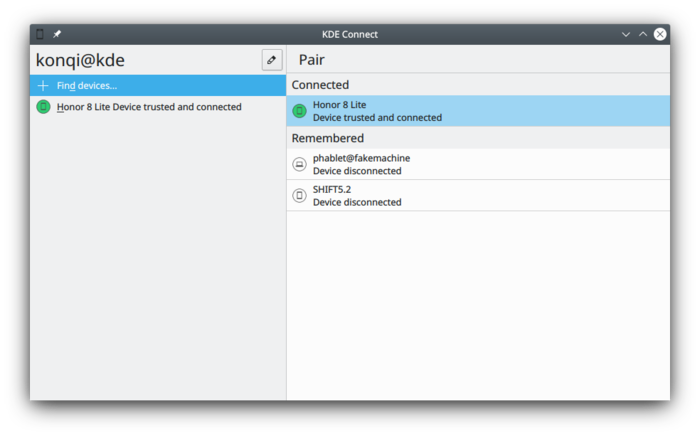
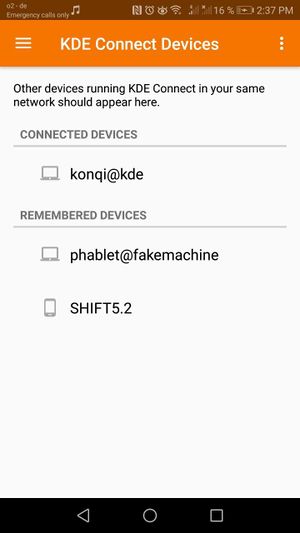
Sie können nun das Pairing auf einem der beiden Geräte starten. Das andere Gerät zeigt nun eine Eingabeaufforderung mit der Bitte das Pairing zu bestätigen. Bitte tun sie dieses - und das war es auch schon! Beide Geräte sind nun verbunden.
Auch wenn eine typische Konfiguration die Verbindung von einem Rechner und einem Smartphone ist, so ist es auch möglich beispielsweise zwei Rechner miteinander zu verbinden.
Browser Integration
Die Plasma-Browser-Integration macht KDE-Connect sogar noch nützlicher. Sie erlaubt es Inhalte z. B. von Youtube oder Netflix von ihrem Smartphone zu steuern und Reiter von ihrem Browser an das Smartphone zu senden. Entgegen seines Namens, kann die Erweiterung auch ohne die Plasma-Arbeitsumgebung genutzt werden.
Gerätenamen ändern
Sie können den Namen eines Gerätes nur auf dem entsprechenden Gerät ändern. Wenn Sie also den Namen ihres Rechners ändern wollen, dann müssen Sie hierzu das Programm in der KDE-Arbeitsumgebung verwenden und wenn Sie den Namen ihres Smartphones oder Tabletts ändern wollen, müssen Sie diese Änderung in der KDE-Connect-App auf diesem Gerät tun. Sobald ein Gerät umbenannt wurde wird dieses automatisch auf allen Geräten synchronisiert.
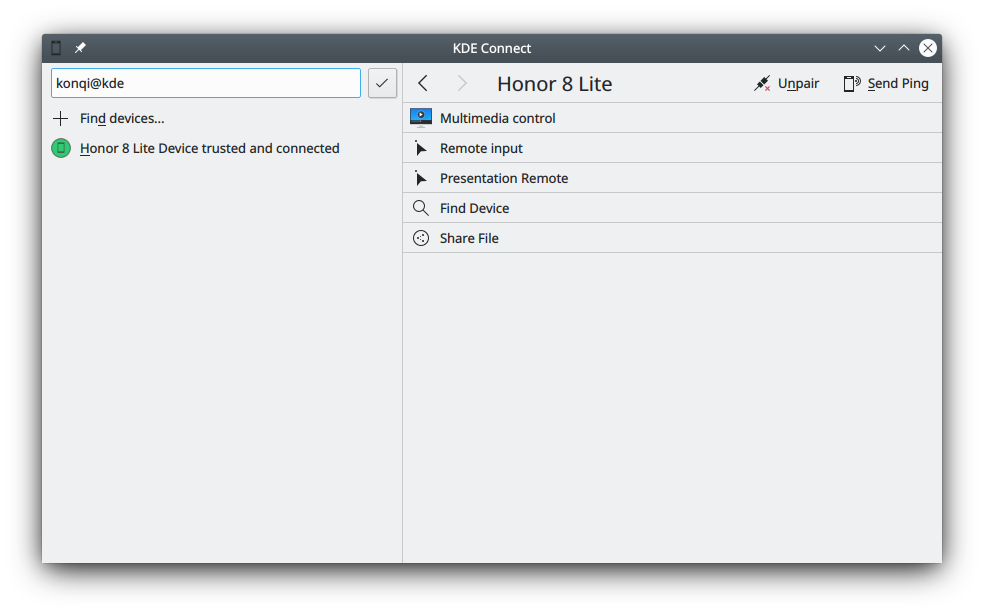
Running KDE Connect over OpenVPN
There may be a variety of reasons for using KDE Connect with a VPN. Maybe you have left home and want to run a command, or maybe you’re on a public wifi network where your devices aren’t allowed to communicate and you want to use the remote control to give a presentation.
Set up OpenVPN
If you have your own server with a public-facing IP address, you can set up OpenVPN yourself. It is not the easiest piece of software to set up, but by following a setup tutorial such as this one, you should be able to manage: https://openvpn.net/howto.html
In order to allow UDP broadcast packets, which are what KDE Connect uses to automatically discover two devices, OpenVPN needs to be set up for bridging (TAP device). If you use a tun device, you can still manually connect by IP address.
If you want to rent a pre-configured OpenVPN service rather than set up your own, it should work, but the same considerations about the server settings need to be taken into account.
Once the server is running, you can use the official OpenVPN client to connect the desktop to the server. There is no official OpenVPN client for Android, but the OpenVPN for Android client works well: https://play.google.com/store/apps/details?id=de.blinkt.openvpn
Once both devices are connected, test that they are able to communicate over the VPN by trying to do a network ping between them.
KDE-Connect einstellen
If your OpenVPN instance is set up for bridging, KDE Connect should work just like on a local network.
If you are using OpenVPN with a tun device, you will have to manually add your devices by IP. Then, once you connect to the VPN, KDE Connect should automatically detect your device and either connect or be ready for pairing!
Verfügbare Erweiterungen
Batterie-Überwachung
"Lassen Sie sich die Akkuanzeige ihres Smartphones neben der des Rechners anzeigen"
Durch das Anklicken dieser Erweiterung ermöglichen Sie es dem KDE-Connect-Mini-Programm den Ladestand ihrer Smartphone-Batterie anzuzeigen.

Zwischenablage
"Teilen Sie die Zwischenablage zwischen den Geräten."
Mit dieser Erweiterung können Sie einfach einen Text von ihrem Rechner kopieren und er wird sofort in die Zwischenablage ihres Smartphones übertragen und andersherum. Dieses funktioniert allerdings nicht mit Bildern.
Inhibit Screensaver
"Inhibit the screensaver when the device is connected."
This makes sure that your screensaver will not run while your device is connected.
Multimedia Control Receiver
"Remote control your music and videos."
With this feature, you can control your music and videos remotely, with pause/play, previous/next, 5 s before/later. You can also change which media player to control, in addition to application and system volume.

Pause Media During Calls
"Pause music/videos during a phone call."
Pause music/videos during a call. This feature can be powerful when combined with Plasma Browser Integration. For example, when you are listening to some music on Peertube or Youtube, the video will be paused whenever you receive a call.
You can configure this option to pause only when you pick up your phone or directly when your phone starts to ring. You can also decide if you want to only pause the media player or/and mute the system sound.
Ping
"Send and receive pings."
This serves to test your connection to a given device. Once selected, a "Ping!" will appear as a notification on your receiving device.
On your desktop, you can send a ping through the KDE Connect settings or through the widget on the tray.
On your phone, you can send a ping through the upper right hamburger menu on the KDE Connect app.
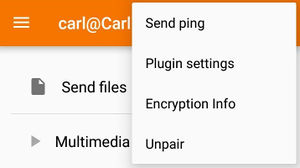
Receive Notifications
"Show your phone notifications on your computer and keep them in sync."
This keeps you in touch with what happens on your phone! Any notifications you receive on your phone will be shown in your computer. Some notifications, such as those of Instant Messengers (IM) like Telegram can be replied on the fly through the computer notification itself.
Remote File System Browser
"Browse the remote device filesystem using SFTP."
This allows you to access your phone storage! When enabled, a device will appear in Dolphin with which you can navigate your external storage.
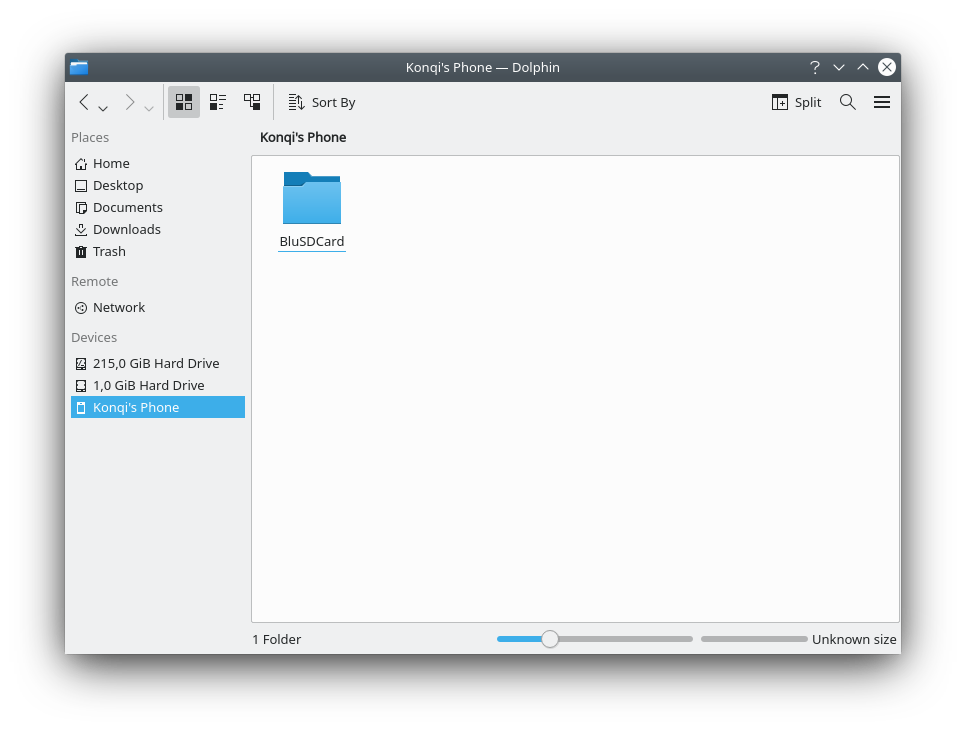
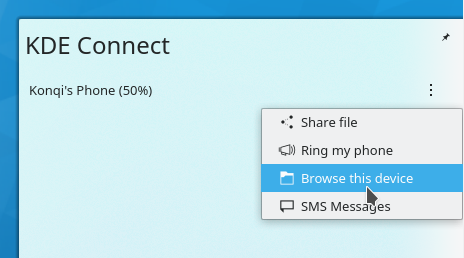
Ring My Phone
"Find your lost phone by making it play an alarm sound."
This also serves to test your connection to a given device, and by ringing your phone remotely, you can quickly find its location!
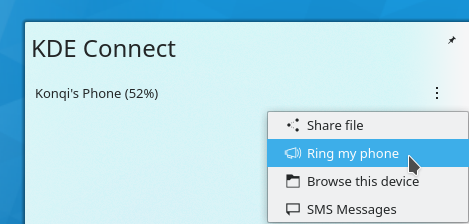
Run Commands
"Execute console commands directly."
With KDE Connect, you can run predefined commands on your computer by pressing buttons on your phone! Instructions on how to add a command are shown in userbase. A set of useful commands can also be found here. Some sample commands, such as suspend and lock screen, are also available.
Send Notifications
"Broadcast this computer's notifications, so they can be shown on other devices."
This is pretty self-explanatory: notifications from your computer will show up on your phone.
You can configure if you want to send the notification description, the icons pertaining to the application and persistent or very important notifications. This keeps you in touch with what happens on your computer! Any notifications you receive on your computer will be shown in your phone.
"Receive and send files, URLs or plain text easily."
This integrates your desktop and your browser so that you can right-click on files or links and send it immediately to your phone!
Files show the right-click option "Send to phone via KDEConnect" and will send the file directly, showing it among your notifications.
Links show the right-click option "Open on phone" and will automatically open your phone's default browser on the chosen website. Really handy!
When receiving files from your phone into your computer, they will go to your Downloads folder by default. If you wish, you can change that too.
Telephone Integration
"Show notifications for incoming calls."
Whenever you get a call on your phone, a notification telling you which number is calling appears. Paired with "Pause media during calls", you'll surely be able to answer readily and never lose a call!
Virtual Input
"Use your phone as a touchpad and keyboard."
With this enabled, by going to your phone app and selecting Remote input, a touch screen will immediately be available for you to control your computer mouse, similarly to a touchpad. One touch equals one click.
The keyboard icon in the upper right allows you to type on your phone and see the result on your computer too.
If you press the hamburger menu right by its side, you'll be able to send right and middle clicks.
Presentation control
It is possible to control presentations using the previous/next slide button. When the device is locked, you can use the volume up/down button to do that. You can also highlight something using the laserpointer. Just move your phone and the blue circle will follow! Using the hamburger menu, you can toggle fullscreen (F5) or quit the presentation (Esc).
Troubleshooting
I have two devices running KDE Connect on the same network, but they can't see each other
KDE Connect uses dynamic ports in the range 1714-1764 for UDP and TCP. So if you are behind a firewall, make sure to open this port range for both TCP and UDP. Otherwise, make sure your network is not blocking UDP broadcast packets.
ufw
If your firewall is ufw, you can open the necessary ports with:
sudo ufw allow 1714:1764/udp
sudo ufw allow 1714:1764/tcp
sudo ufw reload
firewalld
If your firewall is firewalld, you can open the necessary ports with:
sudo firewall-cmd --zone=public --permanent --add-port=1714-1764/tcp
sudo firewall-cmd --zone=public --permanent --add-port=1714-1764/udp
sudo systemctl restart firewalld.service
Fedora firewall
In Fedora, there is an utility for configuring the firewall. Open Firewall Configuration (the program's filename is firewall-config), and in Zones ➔ Services check the kde-connect service.
Make sure you have chosen the Permanent Configuration in the drop-down at the top, otherwise these settings will be reset upon reboot.
iptables
If your firewall is iptables, you can open the necessary ports with:
sudo iptables -I INPUT -i <yourinterface> -p udp --dport 1714:1764 -m state --state NEW,ESTABLISHED -j ACCEPT
sudo iptables -I INPUT -i <yourinterface> -p tcp --dport 1714:1764 -m state --state NEW,ESTABLISHED -j ACCEPT
sudo iptables -A OUTPUT -o <yourinterface> -p udp --sport 1714:1764 -m state --state NEW,ESTABLISHED -j ACCEPT
sudo iptables -A OUTPUT -o <yourinterface> -p tcp --sport 1714:1764 -m state --state NEW,ESTABLISHED -j ACCEPT
KDE Connect crashes or restarts when trying to pair with another device
Sometimes, a corrupt config file may cause KDE Connect to crash when trying to pair with a device. In that case, deleting the config ~/.config/kdeconnect might help.
Can I run KDE Connect without a display server?
Yes, you can pass the command line argument `-platform offscreen` to the daemon (eg: `killall -9 kdeconnectd; /usr/lib/libexec/kdeconnectd -platform offscreen`)
GSConnect
GSConnect is an independent project which implements the KDE Connect protocol into GNOME and uses the same Android app. If you are running GSConnect, please visit that project's GitHub page first for support. If you and the GSConnect team determine the issue is the Android app or protocol, feel free to report those in the KDE Connect bug tracker.
Mein Problem ist nicht in der Liste :(
Für den Fall, dass sie einen Fehler im Programm gefunden haben und ihn melden wollen, können Sie dieses in englischer Sprache im KDE bug tracker.
